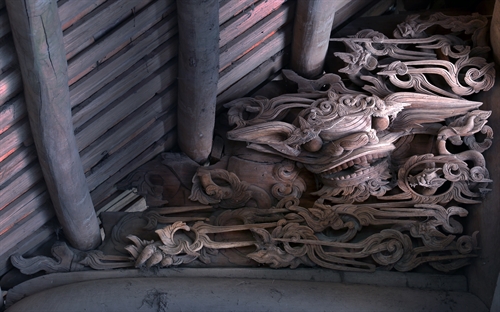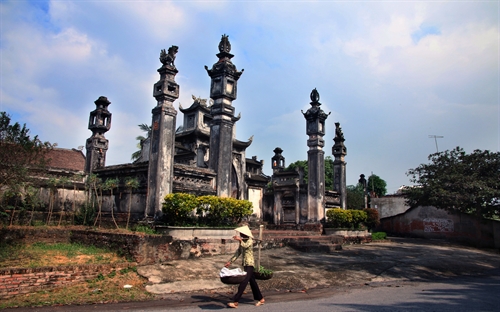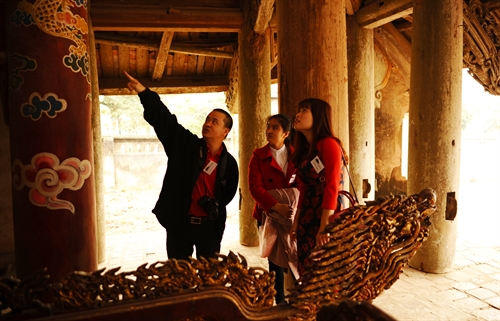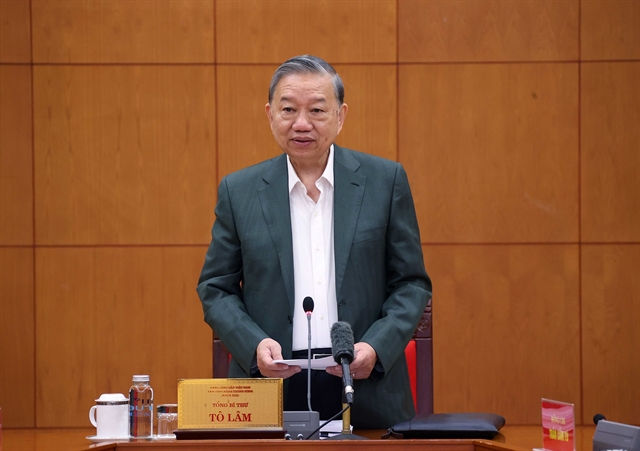 Sunday/Weekend
Sunday/Weekend

Centuries-old communal houses have gone underappreciated, but a group of history lovers wants to help popularise the structures’ cultural and aesthetic values. Lê Hương reports.
 |
| Detailed: Wooden carvings on beams of Do Nghĩa Communal House. — VNS Photo Trần Trung Hiếu |
Centuries-old communal houses have gone underappreciated, but a group of history lovers wants to help popularise the structures’ cultural and aesthetic values. Le Huong reports.
One Sunday morning in late spring, Đinh Quang Trung visited two ancient communal houses in Phú Thọ Province with friends and members of Đình Làng Việt (Vietnamese Communal House) Group.
The cool and fresh air of the countryside seemed to provide energy to 25-year-old Trung and other participants of the trip.
The pastoral beauty of the green fields in the northern province was decorated with xoan trees that were full of white-violet blossoms. A drizzle brought a touch of nostalgia for the visitors.
The group visited two of the most typical communal houses of the westland located about 120km from Hà Nội, Đào Xá in Thanh Thủy District and Do Nghĩa in Lâm Thao District.
The beauty of the houses, built in the 17th and 18th centuries, had been discovered by some of the group’s members when they were searching for material for an ongoing photo exhibition in Hà Nội, entitled Đình Làng Xứ Đoài (Communal House in Westland Area of Old Thăng Long Capital).
Trung and other participants were stunned to see the delicate carvings on pillars and the beauty of the ancient houses. They were also attracted by impressive “xoan” singing performance of young local singers.
“Xoan” or “xuân" singing means spring singing.
Trung had been told by other knowledgeable members of the group that spring was the leisure season when the villages hosted various festivals, and when communal houses and temples got “xoan” troupes to sing and dance as a dedication to local patron saints.
“Xoan singing was very popular centuries ago in the area to the northwest of Thăng Long Citadel, which covers today’s Phú Thọ and Vĩnh Phúc,” researcher Nguyễn Đức Bình, the leader of the group, said. “But today, it’s no longer a favourite. We invited artists from An Thái from Việt Trì City to perform at Do Nghĩa Communal House.”
Many local elders, who joined the group at Do Nghĩa Communal House, were surprised at the “xoan” performance of teenagers.
“About 60 years ago, I followed my parents to watch the same performance at this communal house during spring,” Nguyễn Thị Lành, an elderly woman, said. “At that time I was about years old.”
Bình said that was the purpose of the group.
“We hope to spread the former values of communal houses among today’s urban youth and local rural people, especially when the communal houses are no longer centres for local community gatherings,” he said.
After the “xoan” singing performance, lunch time was even more interesting when the participants shared local delicacies such as “bánh dày” (round sticky cake), and “bánh tai” (ear-shaped cake made of rice stuffed with pork).
“I didn’t understand the value of communal houses in rural areas till I joined the group,” Trung said. “I just saw deserted communal houses with closed doors. They were just solemn, quiet places and difficult to understand, quite different from pagodas that people visit throughout the year.”
Bình said communal houses, when they were first built in the 15th century, were places for community gatherings and folk music performances. At the end of the 18th century, King Gia Long appreciated Confucianism and communal houses gradually became places for gatherings of rich and powerful people in the village. Communal houses also hosted worship activities. In the 17th century, communal houses started worshipping villages’ patron saints.
Communal houses exist throughout the country, and yet the ones in the northern delta and part of the central region were the most typical in terms of function and architecture, Bình said.
The ones in the southern area were more similar to temples, he said.
According to historical documents, communal houses have witnessed various historic periods of the nation. The end of the 17th century was the golden period of the architecture of communal houses, with sophisticated carvings on beams and pillars. The carvings depicted the daily life of ordinary people, dreams for bumper harvests, favourable weather and prosperity. The communal house-style architecture declined at the end of the 18th century and in the early 19th century. During the wars, communal houses were often used as schools and storage areas.
“Though they are renovated here and there, most of the communal houses are no longer places for people’s gatherings,” Bình said. “Instead, they go to newly built cultural houses. The old communal houses are deserted. Many children are even afraid of visiting communal houses as they are afraid of the saints. Cultural activities at the communal house are no longer in full swing as they were in their early period.”
Researcher Trần Lâm Biền said the history of Vietnamese culture and arts was associated with the ups and downs of the nation’s history. Communal house is a typical part of it that adapted to different conditions of history.
“It’s a unique feature as the adaptation is not so clear in any other country,” he said. “Communal houses brought community solidarity, took people away from individualism and, above all, symbolised patriotism.”
Fine arts critic Nguyễn Quân said village culture was the core of Vietnamese culture, and communal houses were places to feature villages’ culture.
“Communal houses used to have four functions, which were spiritual function, religious function, the function of a culture house and as an administrative centre,” he said.
A banyan tree, a water well and a communal house’s yard are images familiar to many Vietnamese people, especially the ones born in the north. The image is the symbol of the motherland.
Protecting heritage
Bình, who works at the culture ministry’s Department for Fine Arts, Photography and Exhibition, set up the Vietnamese Communal House Group on Facebook at the end of 2014 to bring together heritage lovers in general, and communal house lovers in particular.
“At that time, we were interested in pure Vietnamese holy objects displayed at communal houses and other worship places,” he said. “We then also shared knowledge about communal houses such as their architecture, history and culture.”
People from all walks of life participated and shared research, books and updated information about the condition of communal houses in many rural areas, he said.
However, Facebook is just a tool to connect interested people. The group has organised more than 10 field trips to visit communal houses.
“I found the group interesting as I am eager to learn about ancient architecture,” Nguyễn Văn Khởi, an employee of the Hà Nội branch of TAV, a Hong Kong garment company, said. “All members join voluntarily and they just share travel expenses for field trips. I feel relaxed during the trips, while getting a chance to chat with knowledgeable people.”
Nguyễn Thanh Hà, a healthcare devices dealer, has another reason to join the group.
“The communal house had an impressive image during my childhood,” she said. “It’s like the soul of the village. It symbolises pure Vietnamese cultural values. I often take my eight-year-old son with me on the field trips so that he is equipped with the actual knowledge of our ancestors’ values. No school lesson is better than such field trips.”
Hà said the group’s Facebook page was attracting more members and the field trips were luring more participants.
“It means many people are interested in traditional heritage,” she said. “They have just found their suitable playground.”
Third-year student Phạm Vũ Như Mai from the Hà Nội Culture University has found the field trips useful for her study.
“I grasp the information more quickly and remember it better than studying theory in class,” she said.
The group has also offered help to local people in places where the communal houses are dilapidated and have helped to raise funds for renovation work.
It organised two photo exhibitions in August and November last year in Hà Nội to praise the beauty of communal houses, alert people about the poor condition of many communal houses as well as to call for support. Various workshops were held during the exhibitions.
The group has also offered support to people in need in the localities they visit and to the elderly who guard communal houses.
“Our greatest challenge is that we don’t have a lot of funds for a long-term plan,” Bình said.
He said he wanted to set up a foundation for protecting traditional fine arts heritage to prevent degradation of relics.
He also wants to coordinate with travel agencies to offer communal house tours as well as organise field trips [to communal houses] to school students in order to spread knowledge about heritage and nurture a love for ancient values. — VNS
 |
| Ancient: Do Nghĩa Communal House in Phú Thọ Province. - VNS Photo Trần Trung Hiếu |
 |
| Spring celebration: Xoan singing at Do Nghĩa Communal House. VNS Photo Nguyễn Văn Khởi |
 |
| Architecture tour: Nguyễn Đức Bình, founder of the Đình Làng Việt group, explains decorative patterns at a communal house to two visitors at a recent field trip to Phú Thọ Province. VNS Photo Nguyễn Văn Khởi |
 |
| Savoury treat: People make chưng (square sticky rice) cake at So Communal House in Hà Tây District. VNS Photo Nguyễn Tuấn Thành |
 |
| Captive audience: Many local people enjoy Đình Làng Việt Group’s event at Do Nghĩa Communal House. VNS Photo Nguyễn Tuấn Thành |




